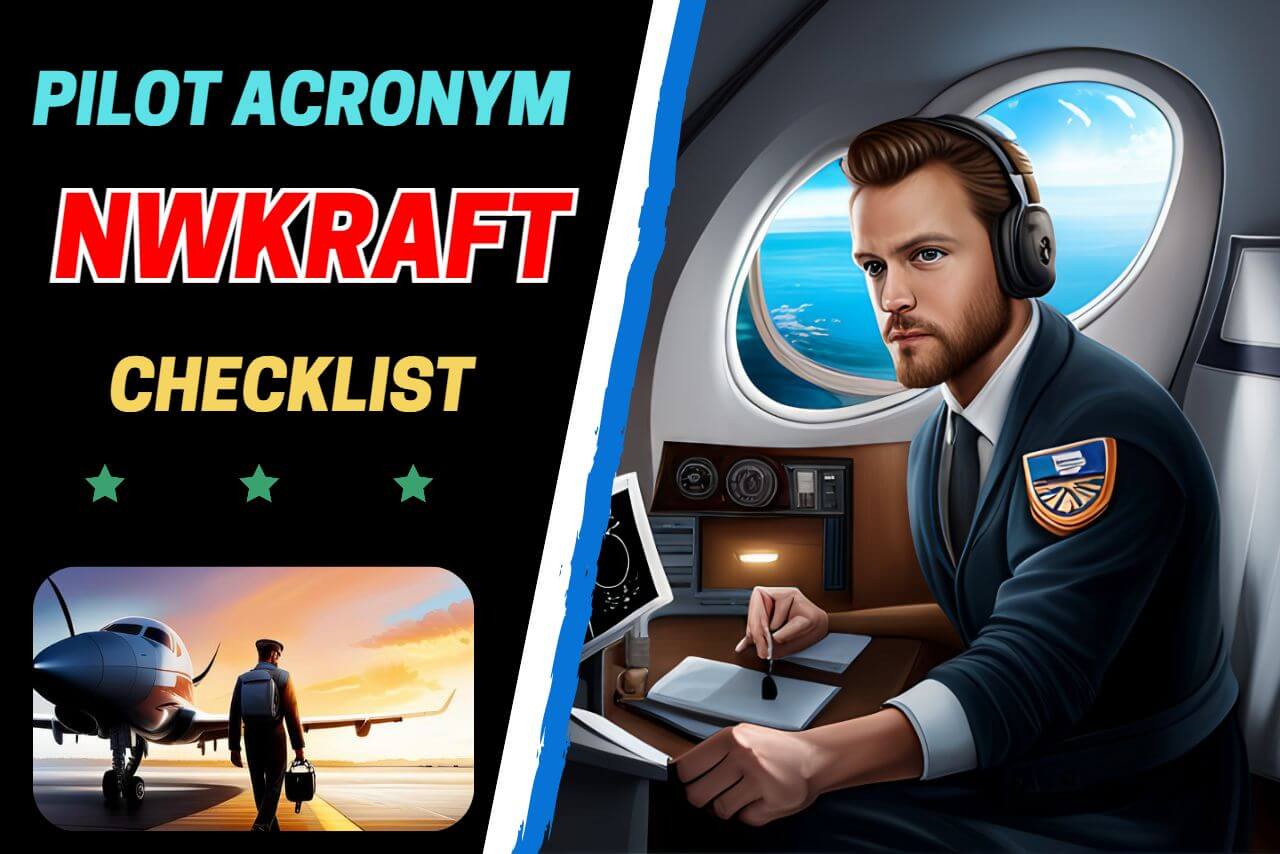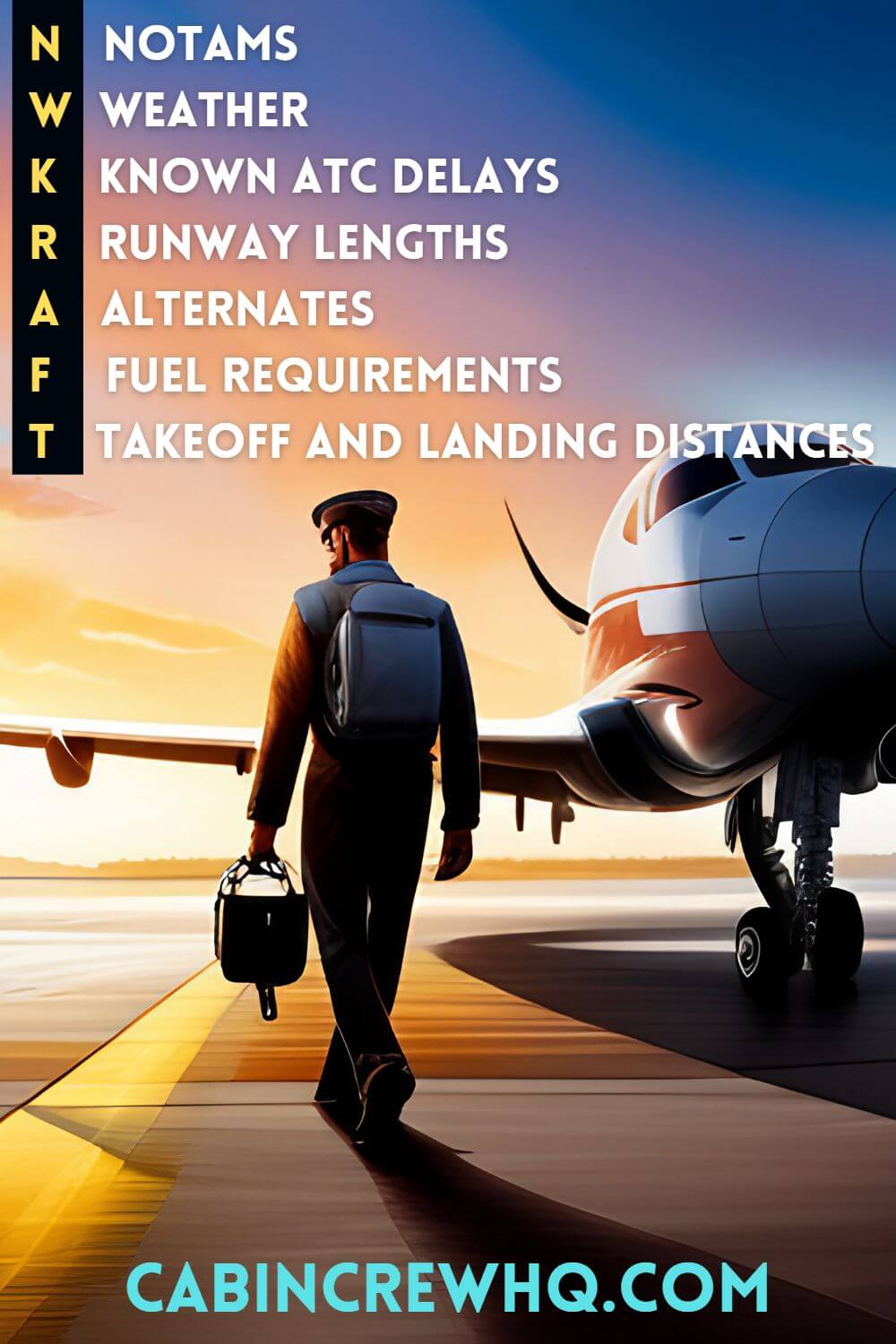Piloting an aircraft is a complex and demanding task that requires constant vigilance, excellent decision-making skills, and comprehensive knowledge of various aspects of aviation. One of the key responsibilities of a pilot is to ensure the safety of the flight by staying informed about the critical factors that can affect the flight’s progress. To help pilots remember these essential elements, the aviation industry has developed several acronyms, one of which is NWKRAFT.
The purpose of NWKRAFT is to provide pilots with a simple and memorable way to recall crucial information that must be considered during pre-flight planning, in-flight decision-making, and post-flight debriefing. This acronym is not only helpful for novice pilots but also serves as a useful reminder for seasoned aviators, emphasizing the importance of thorough preparation and situational awareness.
Also Read: IMSAFE Checklist Acronym: Pilot Fit to Fly Status Pre-Flight
In this article, we will explore the NWKRAFT acronym in detail, discuss its real-life applications, and offer tips on how to effectively use it in your aviation career.
Contents
- Breaking Down the NWKRAFT Acronym
- N: NOTAMs (Notice to Airmen)
- W: Weather
- K: Known ATC Delays
- R: Runway Conditions and Length
- A: Alternates Available
- F: Fuel Requirements
- T: Takeoff and Landing Distances
- Real-life Applications of NWKRAFT
- NWKRAFT in the Context of Aviation Regulations
- Tips for Effectively Using NWKRAFT
- Case Studies: NWKRAFT in Action
- Video: NWKRAFT Explained
- Summary

Breaking Down the NWKRAFT Acronym
NWKRAFT stands for NOTAMs, Weather, Known ATC Delays, Runway Conditions and Length, Alternates, Fuel Requirements, and Takeoff and Landing Distances. Let’s take a closer look at each component of the acronym:
N: NOTAMs (Notice to Airmen)
NOTAMs are time-sensitive notices issued by aviation authorities to inform pilots about potential hazards or changes in the airspace, airport facilities, or navigation aids. These notices play a crucial role in ensuring flight safety, as they help pilots stay updated on any changes that could impact their planned route or destination.
Examples of NOTAMs include temporary airspace restrictions, runway closures, and changes to instrument approach procedures. Pilots are expected to review all relevant NOTAMs during pre-flight planning and stay aware of any updates issued while in flight.
W: Weather
Weather is a critical factor that can significantly impact the safety and efficiency of a flight. Pilots must have a thorough understanding of current and forecasted weather conditions along their planned route and at their destination airport, as it can influence various aspects of the flight, such as fuel consumption, routing, and altitude selection.
During pre-flight planning, pilots should review weather reports, charts, and forecasts to identify potential hazards like turbulence, thunderstorms, icing, or reduced visibility. In addition, they should remain vigilant for updated weather information throughout the flight, as changing conditions may require adjustments to the original plan.
K: Known ATC Delays
Air Traffic Control (ATC) delays can occur for various reasons, such as high traffic volume, runway closures, or equipment malfunctions. These delays can impact the flight’s schedule and fuel consumption, so it’s essential for pilots to be aware of any known ATC delays during pre-flight planning.
By staying informed about ATC delays, pilots can make necessary adjustments to their flight plan, departure time, or routing to minimize the impact of these delays on their flight.
R: Runway Conditions and Length
Runway conditions and length are crucial factors that pilots must consider during pre-flight planning and in-flight decision-making. Factors such as surface type, contamination (e.g., snow, ice, or water), and available runway length can influence aircraft performance, takeoff and landing distances, and approach speeds.
Pilots should review the latest runway condition reports and verify that the available runway length at their destination airport is suitable for their aircraft type and performance capabilities. Additionally, they should remain alert for any changes in runway conditions during the flight, as this may necessitate adjustments to approach or landing procedures.

A: Alternates Available
Alternate Available airports are essential to consider in case the destination airport becomes unavailable due to unforeseen circumstances, such as deteriorating weather conditions, runway closures, or other emergencies. During pre-flight planning, pilots should identify suitable alternate airports along their planned route or near their destination, taking into account factors like runway length and surface conditions, available services, and fuel availability.
Having a well-thought-out plan for alternate airports can help pilots make quick and informed decisions in case of unexpected situations, ensuring the safety of the flight and its passengers.
F: Fuel Requirements
Fuel management is a critical aspect of flight planning and execution, as running out of fuel can have disastrous consequences. Pilots must calculate their fuel requirements based on factors like aircraft performance, planned route, weather conditions, and potential ATC delays. They should also take into account any additional fuel needed to reach an alternate airport or to account for unexpected circumstances during the flight.
By carefully considering their fuel requirements and monitoring fuel consumption throughout the flight, pilots can ensure that they always have enough fuel on board to complete the flight safely and efficiently.
T: Takeoff and Landing Distances
The available runway length at the departure and destination airports must be long enough to support the aircraft’s takeoff and landing performance capabilities. During pre-flight planning, pilots should review their aircraft type’s takeoff and landing distances for various conditions (e.g., dry runway, wet runway, etc.) and verify that these distances are available at both airports. If not, they should identify alternative airports or adjust the flight plan accordingly.
By accurately calculating their takeoff and landing distances before the flight, pilots can ensure that their planned route is safe and suitable for the aircraft’s performance characteristics.
Also Read: AV1ATES Acronym: Required Inspections for Aircraft Airworthiness

Real-life Applications of NWKRAFT
NWKRAFT serves as a valuable tool for pilots at various stages of the flight process:
Pre-flight Planning and Briefing
During the pre-flight planning stage, pilots can use the NWKRAFT acronym as a checklist to ensure they have considered all relevant factors. This helps them develop a comprehensive and well-informed flight plan, increasing the likelihood of a safe and efficient flight.
In-flight Decision Making
While in the air, pilots must continually assess the situation and make necessary adjustments to their flight plan based on any changes in the NWKRAFT factors. By keeping the acronym in mind, pilots can maintain situational awareness and make informed decisions quickly and effectively.
Post-flight Debriefing
After completing a flight, pilots can use the NWKRAFT acronym as a framework for reviewing the events and decisions made during the flight. This can help identify areas for improvement and enhance the pilot’s overall decision-making skills.
NWKRAFT in the Context of Aviation Regulations
Both the Federal Aviation Administration (FAA) and International Civil Aviation Organization (ICAO) have established regulations and standards that emphasize the importance of the factors represented by the NWKRAFT acronym. These regulations serve to promote safety, efficiency, and standardization in aviation operations worldwide.
By incorporating the NWKRAFT acronym into their routine, pilots can ensure they are meeting these regulatory requirements and consistently making well-informed decisions throughout their flights.
Tips for Effectively Using NWKRAFT
Here are some tips to help pilots get the most out of the NWKRAFT acronym:
- Staying Organized: Develop a systematic approach for gathering and reviewing information related to each element of the NWKRAFT acronym. This can help streamline the pre-flight planning process and ensure all relevant factors are considered.
- Regularly Updating Information: Stay alert for updates and changes related to the NWKRAFT factors throughout your flight. Regularly updating your knowledge of these elements can help you maintain situational awareness and make better decisions in real-time.
- Utilizing Technology and Tools: Leverage available technology, such as Electronic Flight Bags (EFBs), flight planning software, and weather apps, to gather, organize, and analyze information related to the NWKRAFT factors. These tools can help pilots stay informed and make more accurate predictions about the factors that may impact their flight.

Case Studies: NWKRAFT in Action
To further illustrate the value of the NWKRAFT acronym, let’s examine a couple of case studies:
Successful Use of NWKRAFT
In this scenario, a pilot carefully reviewed all relevant NOTAMs, weather reports, and fuel requirements during pre-flight planning and identified potential ATC delays and traffic congestion along the planned route. By adjusting the departure time and routing accordingly, the pilot was able to avoid these delays and complete the flight safely and efficiently.
In a different situation, a pilot failed to consider the runway conditions at the destination airport, resulting in a landing attempt on a contaminated runway. The aircraft overran the runway and was significantly damaged. This incident highlights the importance of thoroughly reviewing all NWKRAFT factors during pre-flight planning and remaining vigilant for any changes throughout the flight.
Video: NWKRAFT Explained
Here’s a video from Pilot Flight Academy that provides a comprehensive overview of the NWKRAFT acronym and how it can be used to ensure safe and efficient flights:
By following the NWKRAFT acronym, pilots can ensure that all relevant factors are taken into consideration when planning and executing a flight – from runway conditions, weather forecasts, traffic delays, available services, and fuel availability.
Summary
The NWKRAFT acronym is an invaluable tool that can help pilots maintain situational awareness, make better decisions, and ensure the safety and efficiency of their flights. By incorporating NWKRAFT into their routine, pilots can enhance their overall decision-making skills and contribute to safer skies for everyone.
